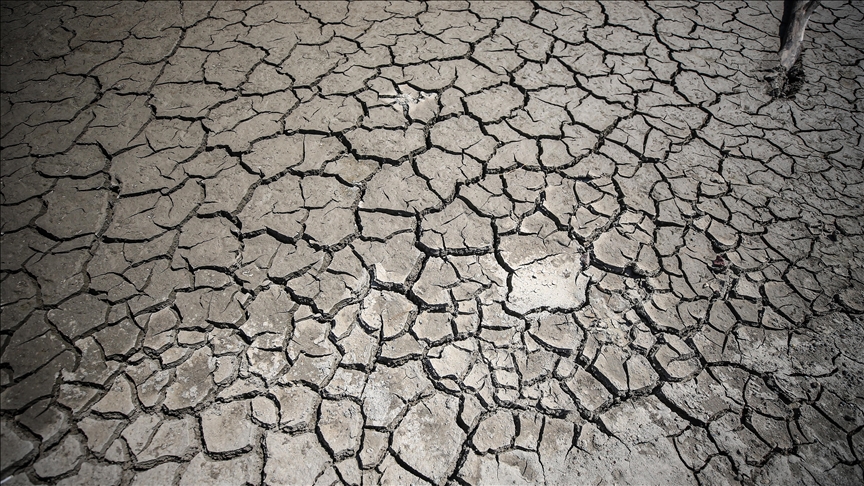Middle East under drought pressure: Agricultural production sounding the alarm
Farmers trying to maintain their production under drought pressure
 File Photo
File Photo
- Problems caused by climate change in the Middle East
- The impact of decreasing water resources on agricultural production
- The pressure of drought on agricultural activities in the Middle East
- Farmers trying to maintain their production under drought pressure
ISTANBUL
As climate change–driven droughts threaten water resources, farmers are experiencing major yield losses compared to previous years because they can no longer meet their irrigation needs.
According to information compiled from various sources for a joint news report by an Anadolu correspondent and the Blue Peace Middle East (BPME) organization, which carries out environment-focused projects.
Effects of climate change are becoming increasingly impactful worldwide. Record-breaking heatwaves, floods, storms, and droughts have now become the norm of life.
According to World Population Review, Kuwait, Cyprus, Oman, Qatar, and Bahrain top the list of countries suffering from water stress. Among Middle Eastern countries, Jordan ranks 15th, Iraq 23rd, and Türkiye 39th.
Data from the Meteorology General Directorate’s Hydrometeorology Department of Türkiye’s Ministry of Environment, Urbanization and Climate Change show that rainfall for the “2024 water year” (October 1, 2023–September 30, 2024) was 4.1% above the long-term average and 10.5% above the previous water year’s levels. Using the 1991–2020 average, Türkiye’s long-term annual rainfall is 573.4 mm, whereas 2024 saw 597 mm.
Changes in rainfall patterns closely affect agricultural activities
As of 2022, the total agricultural land area in Türkiye was determined to be approximately 38.462 million hectares, which corresponds to about 50% of Türkiye's total land area.
According to Turkish Statistical Institute (TUIK) data, plant-based production (excluding cereal and fodder crops) declined by 5% in 2024 compared to the previous year, totaling 75.5 million tons.
Cereal production dropped by 7.5%, to around 39 million tons. Wheat decreased by 5.5% to 20.8 million tons, barley by 12% to 8.1 million tons, rye by 15.7% to 257 thousand tons, oats by 4.9% to 390 thousand tons, and corn by 10% to 8.1 million tons.
While Türkiye is facing these issues, Jordan and Iraq are also struggling with the destructive agricultural impacts of drought.
The proportion of agricultural land to the total land area in Jordan is approximately 10.4%.
Jordan's annual renewable water resources per capita amount to less than 100 cubic meters, which is well below the threshold of 500 cubic meters per capita that defines absolute water scarcity.
Jordan’s Department of Statistics reports that in 2022, the country produced 20,858 tons of wheat, 28,779 tons of barley, 560 tons of lentils, 570 tons of vetch, 6,225 tons of chickpeas, and 22,869 tons of corn; in 2023, these figures fell to 26,697 tons of wheat, 44,496 tons of barley, 511 tons of lentils, 500 tons of vetch, 8,849 tons of chickpeas, and 22,919 tons of corn.
In Iraq, the proportion of agricultural land to the country's total land area is approximately 21.7%.
Iraq relies on the Euphrates and Tigris Rivers for about 98% of its water supply. However, despite being located at the lower basin of these rivers, Iraq receives less water compared to the past. The water volume in the country, which was around 30 billion cubic meters in 1993, has dropped to 9.5 billion cubic meters in recent years. Due to this decline in water resources, the per capita water availability is estimated to reach 479 cubic meters by 2030. This value is significantly below the World Health Organization's standard of 1,700 cubic meters per year.
Iraq’s Central Statistical Organization (COSIT), under the Ministry of Planning, reported in its 2024 Wheat and Barley Production Report that wheat planting area declined by 2.9%, coming to 8.177 million dunams. However, wheat production rose 23.2% to 5.234 million tons, with yield per dunam increasing 26.9%, to 640,1 kg. Barley planting area dropped sharply by 68.4% to 741 thousand dunams, but production still rose by 55.3% to 164 thousand tons, with yield at 222 kg per dunam.
Prof. Dr. Yusuf Demir, Chair of Agricultural Structures and Irrigation at Ondokuz Mayıs University (OMÜ), said climate change has significantly affected Türkiye over the past 10–15 years.
He noted that one of the most affected resources is water. With climate change, drought and desertification are spreading, with a northward shift in desertification in Türkiye.
In the last six months, nearly two-thirds of Türkiye has experienced dominant drought effects. “Almost three-quarters of Türkiye faces drought risk—especially Southeastern Anatolia and the Mediterranean regions. Due to global climate shifts, the climate belt has moved northward from the equator, altering rainfall patterns and causing warming. This warming increases desertification from south to north. That heightens drought risk in those areas and shifts agricultural production and crop patterns,” he said.
Ruba Ajjour, head of Climate Change Studies at the Royal Scientific Society’s Agricultural Research Institute in Jordan, said the biggest effects of climate change in Jordan manifest as temperature increases and reduced rainfall.
She noted that changes in critical parameters—temperature and rainfall—have led to extreme weather events never seen before.
Ajjour explained that Jordan practices both irrigated and rainfed agriculture, and that rainfed (dry) farming has suffered the most, with declines in yields of some vegetables.
In Türkiye, agricultural production is shifting northward in line with climate change, desertification, and drought. Crops like citrus and cotton, traditionally grown in the Mediterranean region, may have to be cultivated in the Black Sea region, Demir said. Globally, production areas for cereals and legumes are moving northward.
Ajjour noted that drought is not new to Jordan, but worsened by climate change. Some lands are no longer arable.
She added that drought has devastated most of Iraq’s farmland, and that drought in Iraq is more severe than in Jordan.
Demir recalled that in Türkiye’s Central Anatolia—often dubbed the “granary” — severe yield losses have occurred in recent years due to drought, and that frost damage earlier this year affected cherry and apricot production. Consumption and production patterns have also changed.
Ajjour projected sharper declines in wheat production than barley due to rising temperatures and reduced rainfall.
She said seasonal shifts combined with water scarcity are creating even harder times. Jordanian farmers are well aware of water scarcity; “in workshops, we told them rainfall would decrease and water would decline, but they didn’t take it seriously because they’d adapted over decades. Now the most affected issues are season shifts, extreme events, soil erosion. Also, due to changes in water, moisture, and perhaps soil structure, we’re seeing diseases we’ve never seen before.”
Cross-border water under climate crisis
Prof. Dr. Aysegul Kibaroglu of MEF University’s Political Science and International Relations department noted that transboundary rivers—shared by two or more countries—have increased, especially since World War II. Nearly half the world’s population depends on transboundary basin regions.
She mentioned the Meric Basin (shared with Bulgaria and Greece), the Coruh basin (Türkiye and Georgia), the Aras basin (Türkiye, Georgia, Azerbaijan, Iran, Armenia), and the Euphrates‐Tigris basin (Euphrates originates significantly in Türkiye, with 10% in Syria; Tigris is 40% Turkish and also flows from Iran and Iraq). The Asi River arises in Lebanon and flows through Syria before entering Türkiye.
Demir said Türkiye has long been portrayed as water-rich, but that’s misleading. With about 1,200 m³ per capita and a population of ~85 million (potentially reaching 100 million including unregistered), Türkiye is nearing the threshold of water scarcity. A value of 8,000 m³ is considered plentiful; 1,000 m³ indicates scarcity; 2,000 m³ signals stress.
Türkiye physically uses 57 billion m³ of its 112 billion m³ water resources, and agriculture uses 45 billion m³—of which 25 billion m³ is lost through inefficiencies.
Kibaroglu emphasized that the Mediterranean basin—one of the most climate‐change–affected—is impacting the Euphrates and Tigris rivers.
Scientific studies predict that in 5–10 years, the Euphrates may lose over 23% of its flow, and the Tigris over 28%.
Ajjour stated that Jordan has been able to maintain agricultural output with less water by sourcing much of it from treated wastewater—used only for certain crops under strict soil and health regulations. But both Jordan and Iraq, however more drought‐prepared now, are facing rapidly worsening situations that threaten food security.
She stressed the need for closed irrigation systems, rainwater harvesting, and crop choice that reduces water use.
Yield losses under drought
Drought caused by climate change is increasingly felt every year, especially by farmers. Each year, farmers report lower yields than the previous year, and they are fighting for survival.
In Türkiye, 4,827,000 people were employed in the agricultural sector in 2024, while it is estimated that in Jordan there were 261,000 people employed in 2023 and in Iraq 968,000 people.
Fevzi Goktas, a farmer from Hacıumur village in Edirne, said,
“We haven’t seen such a drought for many years. In summer, we used to have so much rain that when we planted fields and gardens, like tomatoes, we could gather them ourselves from the fields. But now, unfortunately, we cannot grow them. We are experiencing a severe drought.”
Explaining that there has been a loss in yield compared to last year due to the delayed start of rains regionally, Goktas added, “If we consider Thrace right now, we expect about a 30-40% loss in wheat yield. This drought is not only here; it might be in Tekirdag, Enez, or Dalapasa as well, but right now there is a problem in our region, Thrace. We haven’t seen such a drought for many years. In summer, we used to have so much rain that when we planted fields and gardens, like tomatoes, we could gather them ourselves from the fields. But now, unfortunately, we cannot grow them. We are experiencing a severe drought.”
Great concern for coming years
Farmers rely only on rainwater for irrigation and fear drought will continue next year.
Recai Candemir farming since his father’s death in 2003 in Hacıumur, said they’re facing a drought similar to those in 1987 and 2001:
“Since my father passed in 2003, we have not seen a drought so severe. This year is quite a drought. Crop losses are around 60% right now compared to last year. If it doesn’t rain within a week, sunflowers will also become a problem.”
Candemir said there’s no water source in their fields. At home, they rely on water tankers and pumps, and drinking water is brought from another village 20 km away.
Anadolu Agency website contains only a portion of the news stories offered to subscribers in the AA News Broadcasting System (HAS), and in summarized form. Please contact us for subscription options.


